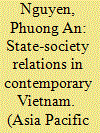| Srl | Item |
| 1 |
ID:
075003


|
|
|
|
|
| Publication |
2006.
|
| Summary/Abstract |
Through reviewing South-East Asia's recent economic engagement with the global economy, this paper points to profound recent transformations in the scope and character of the region's development. Foreign direct investment was the key driver of regional growth in the pre-1997 period, yet currently, the region faces a more difficult and multifaceted economic arena from which to attract such funds. Foreign direct investment is more selective, both geographically and by sector, than was the case in that earlier period. This paper explains the confluence of economics, business practices and politics that are giving rise to these outcomes, and concludes from this that development trajectories in South-East Asia will become more diverse between the countries of the region, with implications for how we understand regional economic performance.
|
|
|
|
|
|
|
|
|
|
|
|
|
|
|
|
| 2 |
ID:
075005


|
|
|
|
|
| Publication |
2006.
|
| Summary/Abstract |
This paper examines the evolution of the dairy complexes of New Zealand and Chile in the context of increasing bilateral interaction between the two countries, and their recent signing of a 'Trans-Pacific Strategic Economic Partnership' (TPSEP) free-trade agreement. The two economies can be said to occupy semi-peripheral positions in global markets and have, through the twentieth and into the twenty-first century, increasingly competed for market share in a range of primary product (particularly agricultural)-based export markets. Similar sets of historical processes, although variably timed, have shaped the roles of New Zealand and Chile respectively as resource peripheries, and the extent to which the two countries can collaborate for mutual benefit and transcend these roles is uncertain. In taking a sectoral approach this paper questions the compatibility of the two dairy complexes in the context of the TPSEP, and recommends further sectoral and localised studies in order to better appraise the model of 'co-opetition' promoted through the agreement.
|
|
|
|
|
|
|
|
|
|
|
|
|
|
|
|
| 3 |
ID:
075004


|
|
|
|
|
| Publication |
2006.
|
| Summary/Abstract |
This paper offers an analysis of the relations between youth and the socialist state in contemporary Vietnam, which sheds light on the wider state-society relations. Amid rapid social changes brought about by economic liberalisation, the Vietnamese Communist Party and socialist state may no longer be the sole driving force that motivates young people. As they seek to be both in control of and in touch with youth, the leaders of the Party and state find themselves negotiating between maintaining their ideological integrity and accommodating the changing needs and desires of youth. An analysis of recent events demonstrates that youth are no longer merely a subject of political propaganda and mass mobilisation, but instead they have evolved to become an important social actor urging the leadership to further reform itself. As young people express a desire to embrace socioeconomic and cultural changes wrought by processes of marketisation and globalisation, the Party and state are actively reforming themselves not only to respond to young people's desires and aspirations, but also to strengthen their political authority and leadership, and to consolidate their control and management of youth amid the new conditions of a market-oriented society. Overall, this paper sheds light on the changes in what is considered to be the 'strategic' relationship between the state and youth, and the wider process of sociopolitical transformation in present-day Vietnam.
|
|
|
|
|
|
|
|
|
|
|
|
|
|
|
|